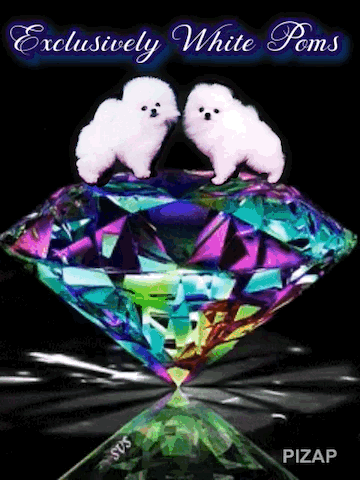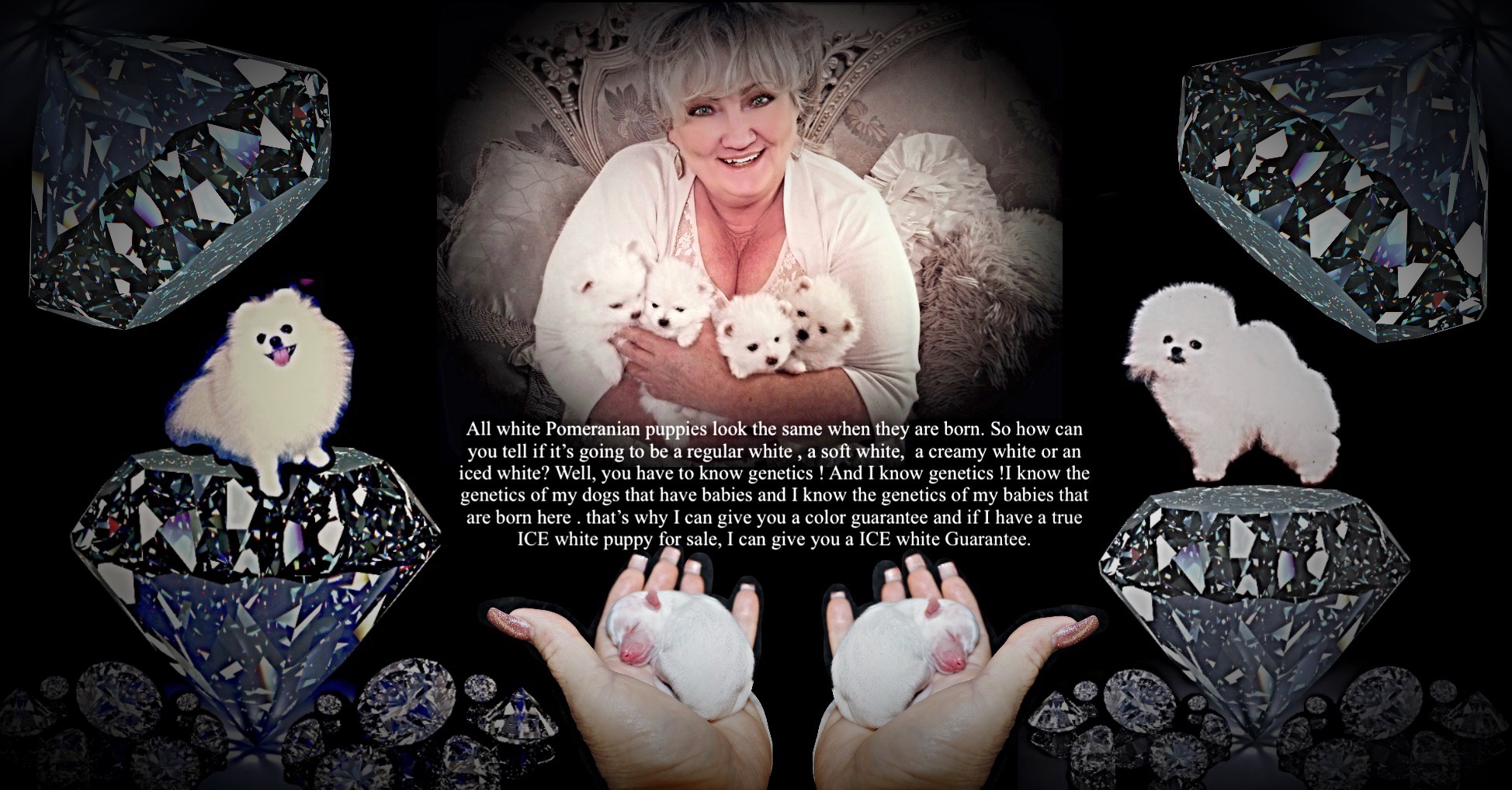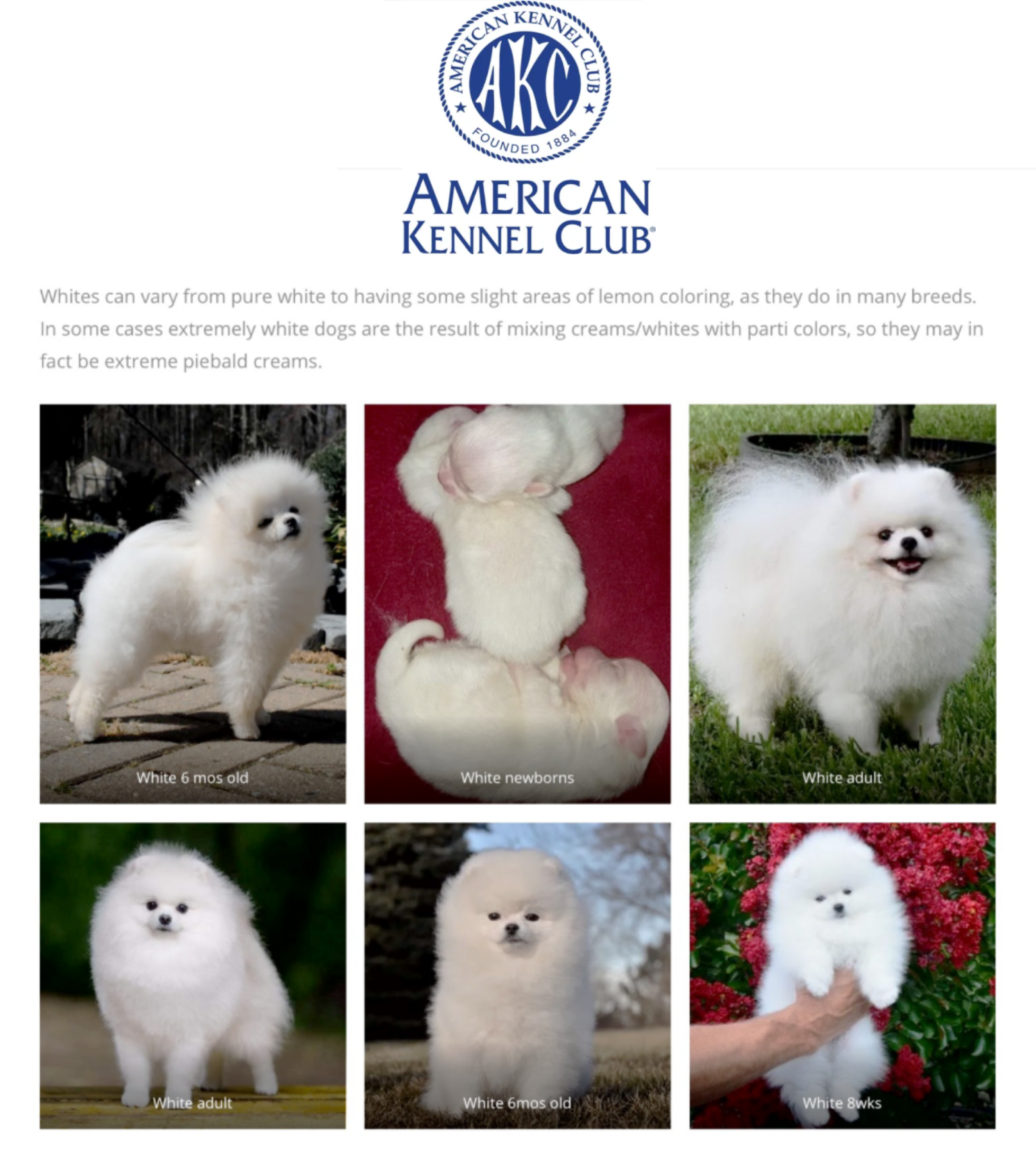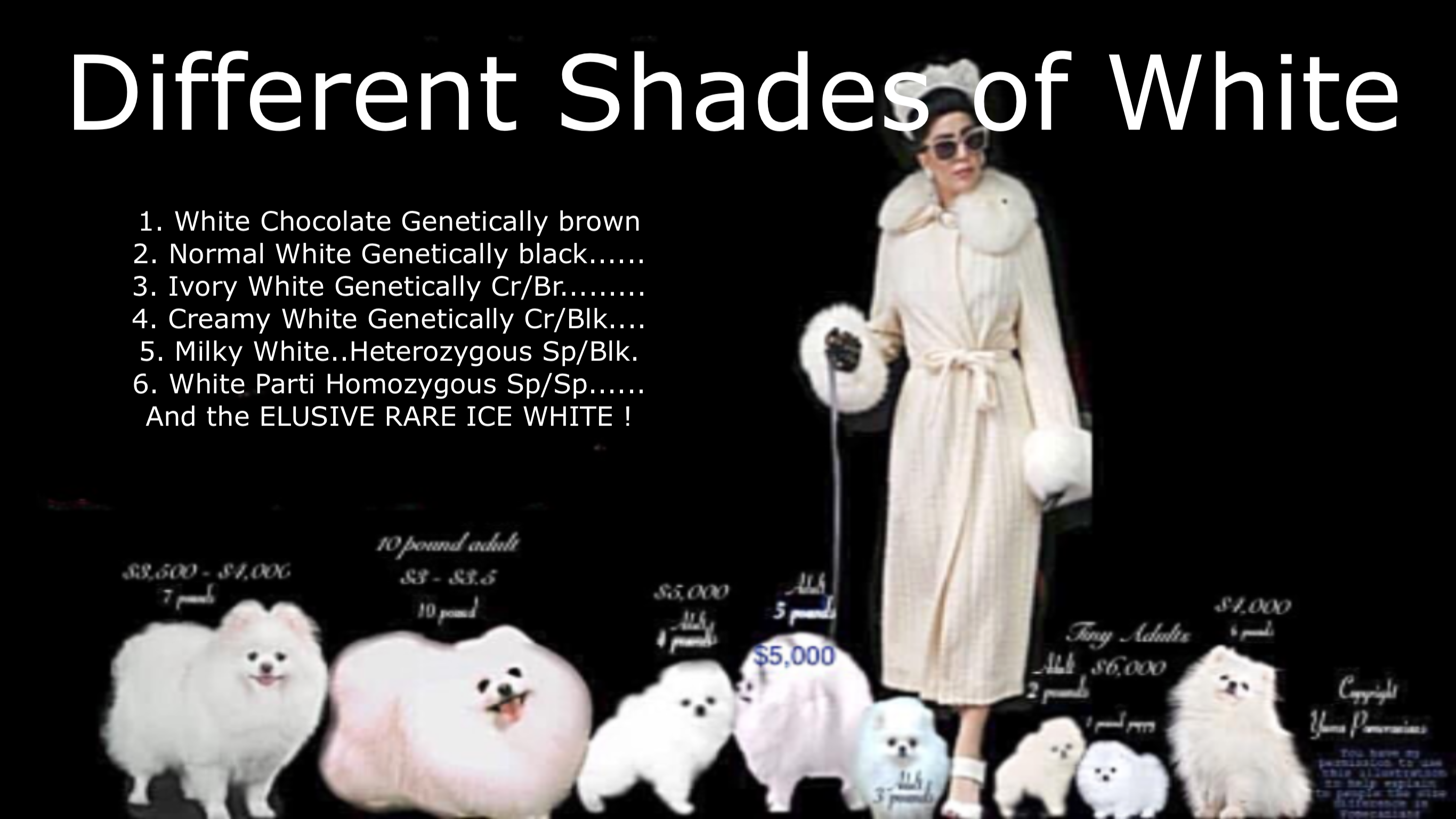

 There are many shades of white.
There are many shades of white. 
- ICE WHITE e/e genotype Homozygous Sp HAS BLACK NOSE
- WHITE CHOCOLATE /E/E b/b d/d AND c/c LIVER COLORED NOSE
- SOFT WHITE carried a recessivee allele in their MC1R genotype.
- MILKY WHITE must have had a MC1R genotype of at least of E/e,
- SILVER b/b/ d/d AND C/c ( BLACK NOSE ) SILVER
- CREAMY WHITE E / e b/b d/d AND C/c BLACK NOSE
- IVORY. E/E b/b d/d
- EXTREME LIGHT CREME SABLE dark mussel AT BIRTH DISAPPEARED IN THE ADULT STAGE indicating he may carry an Em allele in his genotype
- Normal White e/e genotype Heterozygous Sp HAS BLACK NOSE
- WHITE PARTI TOTALLY WHITE / no spots. Homozygous Sp/Sp
genetically speaking there are hundreds of variables in determining the genetic code responsible for the color of a dogs coat
The Genetics even vary depending on the breed of dog . So getting into the Genetics of dog coat colors is a very extensive subject
Just to give you an idea of what I am talking about.... If you narrow down the genetic codes to coat color in just the pomeranian breed you have :
NON EXTENTION BLACK ( WHITE )
- b/b/ d/d AND C/c ( BLACK NOSE ) SILVER
- b/b/ d/d AND c/c ( BLACK NOSE ) ICE WHITE
- E/E b/b d/d AND c/c ( Liver nose ) WHITE CHOCOLATE
- e / e b/b d/d AND C/C ( BLACK NOSE ) MILKY WHITE
- E / e b/b d/d AND C/c ( BLACK NOSE ) SOFT WHITE
- E / e b/b d/d AND c/c ( BLACK NOSE ) ICE WHITE
NON-EXTENSION RED (white): ~~ "c^e" - is 'extreme dilution'. It causes tan to become almost white.
- B/B d/d e/e = c/c dilute red to pale cream with gray nose (dog is genetically a
dilute black, but will be a WHITE color) - B/b d/d e/e = c/c dilute red to pale cream with gray nose (dog is genetically a dilute
black, but will be a WHITE color) - b/b d/d e/e = c/c dilute red to pale cream with rosey-brown nose (dog is genetically
dilute brown, but will be WHITE color) - b/b D/d e/e = c/c dilute red to pale cream with brown nose (dog is genetically
brown, but will be WHITE color) - b/b D/D e/e = c/c dilute red to pale cream with brown nose (dog is genetically
brown, but will be WHITE color) - B/B D/D e/e c/c/ = dilute red to pale cream with black nose (dog is genetically black,
but will be WHITE color) - B/b D/d e/e c/c = dilute red to pale cream with black nose (dog is genetically black,
but will be WHITE color)
NON-EXTENSION RED (cream): with a C/c added to the mix............
- B/B d/d e/e = dilute red to pale cream with gray nose (dog is genetically a
dilute black, but will be a cream color) - B/b d/d e/e = dilute red to pale cream with gray nose (dog is genetically a dilute
black, but will be a cream color) - b/b d/d e/e = dilute red to pale cream with rosey-brown nose (dog is genetically
dilute brown, but will be cream color) - b/b D/d e/e = dilute red to pale cream with brown nose (dog is genetically
brown, but will be cream color) - b/b D/D e/e = dilute red to pale cream with brown nose (dog is genetically
brown, but will be cream color) - B/B D/D e/e = dilute red to pale cream with black nose (dog is genetically black,
but will be cream color) - B/b D/d e/e = dilute red to pale cream with black nose (dog is genetically black,
but will be cream color)
.....................................................................AND THAT IS JUST BARLY SCRATCHING THE SURFACE OF POMERANIAN COAT COLOR GENETICS !
There are many shades of white.
- C full color, allows full expression of whatever pigment is prescribed by other genes. Most dogs are CC.
- cch, chinchilla or silver, when present in double dose removes most or all of the phaeomelanin pigment with only a slight effect on black pigment. This is named after a small fur-bearing South American rodent called the chinchilla. Black and silver replacing black and tan, or a wolf-like color without the extra banding (see aw, above) may also be due to a cchcch genotype. Dogs with very light tan probably are cchcch or something similar. Liver dogs show lightening even of eumelanin pigment, and the "deadgrass" color of the Chesapeake Bay Retriever is thought to be due to a bbcchcchgenetic makeup. The possibility of other, rufous modifiers affecting the shade of phaeomelanin pigment needs to be kept in mind, as does the possibility of more than one form of chinchilla in the dog - rabbits are thought to have three.
- ce, extreme dilution, has also been proposed for the dog. This gene may be part of the makeup of some "white" dog breeds where the white color is due to extreme dilution of tan. The West Highland White Terrier may be ceceee. A cross to a black and tan breed would be interesting from the point of view of color genetics. Eyes may be lightened in some species, but this is doubtful in dogs.
- ch, Himalyan, is not known to occur in the dog. In homozygous form, it makes the formation of eumelanin dependant on the temperature of the skin. Thus a genetically solid black animal will have reduced black on the extremities (seal brown) and an almost white color on the body. The effect on tan/orange pigment is confusing - the tan in agouti hairs is removed, but that resulting from the orange gene in cats (not in dogs) remains intense on the extremities. There is reason to suspect that this gene, as well as some forms of chinchilla, also affects the organization of the brain, particularly in the neural pathways from the eyes to the brain. There may be a reason for Siamese cats to be cross-eyed. Eyes are normally blue or pink.
- cp, platinum, is optically similar to albino but retains very slight tysonase activity and in the mouse is described as retaining some luster in the coat as opposed to the pure white seen in albino. Although there is a total absense of proof one way or the other, I would hypothesize that the white Pomeranian , with pale blue eyes and pink nose, is due to a homologous gene.
- c, albino, had not known to occur in the dog as a regular part of any breed color, though possible candidates for mutations to c have been recorded.
- As mentioned above, the c gene cannot produce working tyrosinase, and a cc individual cannot produce melanin pigment.
As seen from the above, C is known to have a number of different forms and effects. The usual assumption is that dogs have at least one mutant allele, cchwhich when homozygous lightens phaeomelanin (yellow) pigment to cream and more weakly affects liver and longhaired black. A second proposed allele, ce may be responsible for further reduction of cream to white in some breeds, or modifying alleles may be responsible for the further lightening in these cases. While some forms of C modify eye pigment (e.g., blue eyes in Siamese cats) there is little evidence for this in dogs unless "white" Dobermans are indeed due to a C-locus mutation. Although C appears to be fully dominant over any of the other alleles, the dominance relationship between the others generally goes in the direction of more color incompletely dominant over less color, the heterozygote generally resembling but not necessarily identical to the homozygote with more pigment
D, the dilution series. This, again, is a relatively simple series, containing D (dominant, full pigmentation) and d (recessive, dilute pigment). In contrast to C, which has its strongest effect on phaeomelanin, or B, which effects only eumelanin, D affects both eumelanin and phaeomelanin pigment. It is thought to act by causing the clumping of pigment granules in the hair. Like B, it often affects skin and eye color, and in some breeds dd has been associated with skin problems. "Maltese blue" is a term often used to describe dd blacks. If a solid liver dog also is dd, the result is the silvery color seen in Weimararners and known as "fawn" in Dobermans. (In most breeds, fawn refers to ay yellows.)
While dd acting on black or liver is a part of the genotype of several breeds, dd acting on sable is relatively rare. For one thing, the action of dd on phaeomelanin has been described as a flattening or dulling of color. The cinnamon color in Chows is probably due to an ayaydd genotype, but otherwise the combination of dd with phaeomelanin coat color seems limited to breeds in which color is of little importance (e.g., blue brindle in Whippets.)
Although D is usually described as completely dominant to d, I have seen one blue merle Sheltie bitch who suggested that this may not always be the case. The black merling patches in this bitch were actually an extremely dark blue-gray. Other than this she was an excellently colored blue merle. The owner insisted that she was not a maltese blue, but that she had relatives who were. I suspect that this bitch may have been Dd, with the additional diluting effect of the merle gene allowing the normally hidden effect of a single dose of d to show through.
E, the extension series. This series is probably the least satisfactory of those generally assumed to exist in the dog. In most mammals, the E series includes Ed (dominant black), E (normal extension) and e (recessive red or yellow, and sometimes some intermediate alleles called Japanese brindles. In dogs, this is clearly not the case; breeding experiments have conclusively proven that dominant black and recessive red are not in the same series. This has led to dominant black being thrust into the A series, which as already mentioned conflicts with results in other mammals.
In this summary, I will give the genes as postulated by Little, followed by a brief discussion of other possible explanations and a suggestion for matings that might clarify the situation. Note that the question is not in whether the genes occur, but whether they are in fact alleles in the same gene series. With regard to e and E, recent sequencing of the e and E genes in dogs show definite homology with those in other species.
NOTE: Newer research indicates a chinchilla-like mutation occurs in dogs, although, tyrosinase activity hasn't
belong in this series. Also, there may be more than one form of the chinchilla gene.
~~ "c^e" - is 'extreme dilution'. It causes tan to become almost white.
~~ "c^b" - or blue-eyed albino. This is an entirely white coat with a very small amount of residual pigment in the
eyes, giving pale blue eyes. It is also called platinum or silver. This allelic pair could be responsible for the white
coated, pink skinned, blue-eyed Pomeranians.
~~ "c^c" - true pink-eyed albino. Has not been seen in dogs.
Albino - C gene
This gene affects the intensity of melanin production in the coat hairs. The normal or dominant form, C, is what might be termed 'full color'. There are however various incompletely dominant mutant alleles postulated for this locus, with varying effects on color intensity. These mutant forms are temperature sensitive - the higher the temperature, the more effective they are (i.e, the lighter the color).
Almost all dogs are CC at this locus - full color.
The lower series alleles that have been suggested include, in order of decreasing dominance, cch, ce, cb and c.
The first, cch, is chinchilla. This lightens most or all of the phaemelanin with little or no effect on eumelanin. E.g. it turns black+tan to black+silver.
The next allele, ce, is 'extreme dilution'. Causes tan to become almost white. It is thought that the white labrador might bece with another, lower, C series allele. The ce allele may be responsible for producing white hair in other breeds of dogs, like the West Highland White Terrier, while allowing full expression of dark nose and eye pigment
Moving on down we have cb, or blue-eyed albino. This is an entirely white coat but with a very small amount of residual pigment in the eyes, giving pale blue eyes. This is known as ca in cats. Can be called platinum or silver.
Finally we have c, true pink-eyed albino. This doesn't seem to occur in dogs.
SILVER d/d AND C/c
ICE WHITE d/d AND c/c ( BLACK NOSE )
WHITE CHOCOLATE E/E b/b d/d AND c/c ( PINK POINTS LIGHT EYES )
CREAM e / e b/b d/d AND C/C
CREAMY WHITE E / e b/b d/d AND C/c ( CREAMY AND ICE CREAM)
ICE WHITE E / e b/b d/d AND c/c
~~ "c^b" - or blue-eyed albino. This is an entirely white coat with a very small amount of residual pigment in the
eyes, giving pale blue eyes. It is also called platinum or silver. This allelic pair could be responsible for the white
coated, pink skinned, BLUE -eyed POMERANIAN ( VERY RARE )
~~ "c^c" - true pink-eyed albino.